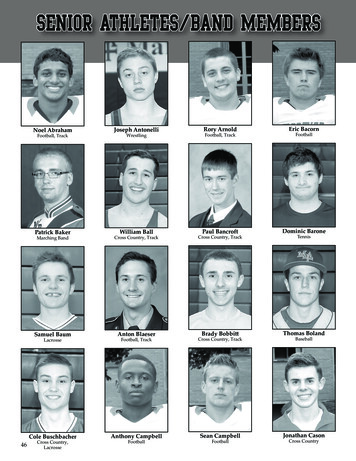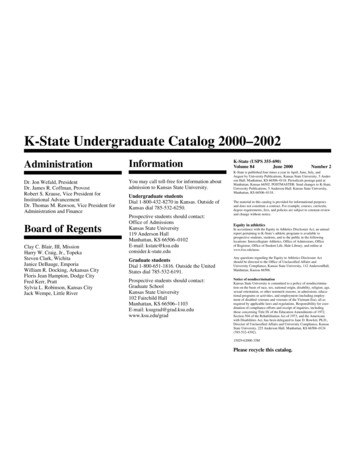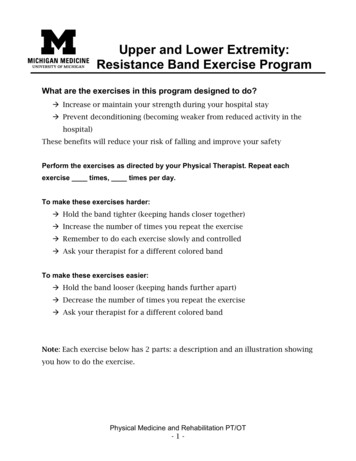
Transcription
2018 Kansas StateMarching BandLeader Handbook
2018 StaffDirector of BandsDr. Frank TraczAssistant Director of BandsDr. Alex WimmerSenior Administrative AssistantCourtney GrecuGraduate AssistantsJay KoupalBrandon AdamsAndrew TinsmanAllegra FisherEddie ShawClassy Cats/Twirler CoordinatorHeidi HiltonColor Guard CoordinatorStudent Color Guard CoordinatorSpecner SmithMaggie MikschCheerleading/Mascot CoachDani RuoffStudent Staff*Trevyn Sell*Trace Woods (perc)Abby GilesCarrie GoodsonShelbie GreenMegan RobinsonKathleen WalkerJessica BrummelManagersTravis GreenBryant KniffinPhotographersScott SewellLBJ StudiosVideoBryant KniffinAnnouncerBill Hurrelbrink
2018 LeadershipDrum Major ///Blake MorisAsst Drum Major ///Bailey EisenbraunMadison HinesPiccolo ///SL/MI Abby HuckMM Tine GreenASL Shelby FosterASL Emilie ChristianClarinet ///SL Caleb OedingMM Rachel MallonMI Alec MitchellASL Hannah BaetenASL Michelle VillagranaAlto Sax ///SL Ben TrickeyMM Brett BroadbentMI Josh RusselASL Cedric BarnesTenor Sax ///SL/MI Alex MeekMM Jessica KeaneASL Garret BinnsASL Sean AlumbaughTrumpet ///SL Jacob SweattMM Brooks ArmstrongMI Steven SchmollASL Jacob NicholsASL Anna MurphyMellophone ///SL Molly MulqueenMM Kara WhitakerMI Justin GittleASL Paige KyleTrombone ///SL Josh MarshallMI Wesley CrowMM Truman SteehnASL Haley MillsASL Ben RajewskiBaritone ///SL/MI Nicole BuehlerMMReece LeonardASL Calvin KochTuba ///SL Steven RobinsonMM Clayton KistnerMIDawson JohannesASL Tyler KodanazASL Rory BowellPercussion ///SNPreston ThomasASN Gage OberhueTNCole KlinkhammerBD Jacob DobbsABD Jillian BorelCY Kathrine VenturaACY Lucy FlorezClassy Cats ///SL Hannah EckASL Paige DacusASL Ashton ThomasASL Maggie KohlrusColor Guard ///SL Maggie MikschASL Zoey DutcherMM Hannah KochevarASL Ellen ReardonTwirler ///SL Delaney Madden
Dear “Leader of the Pride,”The “title” you have earned is one that reflectsyour years of hard work, dedication, and commitmentto this band. Congrats. You have certainly earned thehonor and privilege to lead your peers. You will nowexperience one of the most challenging, frustrating,fulfilling, and wonderful times of your young life. Thisexperience will challenge you to be your best whenyou do not feel like it. It will ask you to motivate peoplewho you think are not easily motivated. It will push youto new areas of “people skills” that you didn’t know existed within you. In short, you will become who you willbe for the rest of your life.The college years move by very quickly. Some ofus never realize the opportunity to learn and grow thatis afforded to us. This is one of those times and experiences that will change you and the people aroundyou. Use this time and title wisely. Use this responsibilityto see who you are and see what you will become.Use this to better those around you and learn who youare.Go Cats, Go Band!!DT
REALITY CHECK:As a leader of this band, YOU help build us tobecome the greatest we can be. You are no longersolely a follower in this organization! Everything you dothat might be seen by a fellow bandsman on and offthe field is a reflection of what is deemed “OK” by theleaders in this band. Think of how you present yourselfon a day-to-day basis and think of how a rookie mightperceive your actions and words.You are a person of great ability, intellect,reliability, work ethic, and responsibility. If not, youwould never have made it this far. Your insistence ongreatness is paramount to the success of this ensembleas both a performance group and as a reflection ofwhat this school represents. The fruits of your labor willbe seen by the 50,000 fans that fill Bill Snyder FamilyStadium every week, and the millions that watch fromaround the world.The apathetic, lethargic, and sometimesquestionable attitude of your peers will test yourabilities as both a teacher and a performer. Keepyour head held high and never settle for anything lessthan the best. Never be ashamed to ask for help fromyour superiors, as their combined experiences are anundoubted cache of resources for someone in yourposition.
Social Media Policy:AS AN INTERNET USER, you agree to maintain and protect the confidentiality of band information and observe the right to privacy of Band Members, GraduateStudents, Professors and Band Staff. Personal information provided to the Internet must not bring disrespect,contempt or ridicule to the band, the School of Musicor the University.Regardless of your privacy settings, inappropriate postings to Facebook, Instagram, Snapchat, Twitter, or anyother Internet, personal or social networking site include, but are not limited to: confidential band information alcohol or drug related photos use of weapons sexually explicit photos slander, defamation, or any language which bringsembarrassment to the band, School of Music or theUniversityConceal Carry PolicyIn this class, students will be asked on a regular basis toparticipate in activities, such as engaging in group work,using the board, or performing in small and large ensembles.These activities may require students to either be separatedfrom their bags or be prepared to keep their bags with themat all times during such activities. Therefore, no concealedweapons will be allowed in athletic or concert ensemblerehearsals and/or performances. Students are encouragedto take the online weapons policy education module(k-state.edu/police/weapons/index.html) to ensure theyunderstand the requirements related to concealed carry.This includes all travel, athletic events, concertperformances, sectionals, and all rehearsals indoor andoutdoor.
Use of this HandbookThe Kansas State University Marching Band StudentLeader Handbook is designed to clarify details ofmarching fundamentals and to improve teaching andleadership abilities of Section Leaders.This handbook will address proven methods to effectively teach your section music, marching maneuvers,and general “band how-to” throughout band campand the rest of the season. If you ever have any questions about what is covered here, feel free to contactyour superiors for help or clarification.Seminar Goals:1. Policies & Procedures2. Band Schedule for the Year3. Rehearsal Schedule4. Student Leader Handbook5. Band Handbook6. Rosters & Charting7. Auditions & Part Placement8. Rehearsal Tips9. Instruments & Uniforms10. Band Camp Schedule11. Stand Activities12. Practice Attire & Gameday Attire13. Marching Style14. Stands Music & Show Music15. Pre-Game Music16. Rosters17. Motivation18. Rookie Life19. Vet Life20. Our Goals21. EMAW
Band CampBand camp is a concentrated program of physical andmental conditioning for performances during the football season. The goals include: To review and sharpen staff performance andteaching skills. To teach new members the marching and playingfundamentals necessary to successfully contributeto the KSUMB. To help new members establish personal standardsfor performance and achieve a sense of dedicationto the organization. To revitalize returning members by reviewing fundamentals while focusing their energy toward higherstandards of performance. To mold rookies and vets into one cohesive group. To establish rehearsal attitudes and procedureswhich will allow for maximum accomplishmentduring a minimal timeframe. To prepare music and drill for initial performance.This week affords us the opportunity to accomplishwhat would normally take over five weeks of normalrehearsal time in just one week. As such, it is imperativethat we make the most of this time in order to ensure asuccessful season ahead. This success begins with YOU!Make your rookies feel like a part of the group, never alienated. Not only are they now a part of a newmarching band, but they are also now living on theirown for the first time in their lives! Remember what itwas like for yourself as a rookie and imagine the thingsthat you would have liked to see from the vets at thattime. Help them acclimate to their new way of life,both on and off the field.
Teaching1. State the name of the fundamental.2. Model the command in a CLEAR, STRONG voicewith something to give a beat. Repeat this severaltimes, addressing different small points of the fundamental.3. Give the command and have your rank perform.Remember that SPEED KILLS. Have them go slowlyat first, and “by the numbers” if necessary.4. Stress the importance of clean, “snappy” motions ineverything.5. Continue this method until everyone in the rank cansuccessfully perform the fundamental multiple timesin a row.6. If there are members of the rank struggling, let anASL, DM, or GA take them aside and work withthem.7. STAY POSITIVE. It can seem no matter how manytimes and different ways you present something thatthe rank still does not understand. ASK THEM whatexactly they don’t understand if you are at yourwit’s end.8. Point out superior form and help the rookies ratherthat berate them. This is all new to them!
Fundamentals Teaching OrderIN PLACE FUNDAMENTALS:1. Parade Rest2. Attention3. Parade Rest from Attention4. Mark Time/Halt5. Left Face/Right Face6. About Face7. Dress Center/Right/LeftMOVING FUNDAMENTALS:1. Forward March/Band halt2. Left Flank/Right Flank3. Backward March4. Power Step5. Slide6. Step-Forward-Back-TurnHORN MOVES:1. Horns Up/Horns Down/ Flash/Spread & Flash
Marching FundamentalsAttention: Heels together, toestogether Legs straight, knees notlocked Hips above ankles Shoulders back and down Head above the horizonParade Rest: Left leg moves out on “REST,”while right remains stationary Feet shoulder width apart Left hand behind back in blade,parallel to the ground, thumb ontop of the blade Right hand: Instrument carriage depends onsection
Facings:Right Face:Rotate right foot (on heel) 90degrees to the right, whilerotating the left foot (ontoe) at the same time. Torsomoves to the right with feet.Snap Left foot forward tomeet the right on count two.Left Face:Rotate left foot (on heel)90 degrees to the left, whierotating the right foot (ontoe) at the same time. Torsomoves to the left with feet.Snap Right foot forward tomeet the left on count two.About Face:Spread and Flash: Left foot comes out shoulder width apart, feet are parallel Slight bend backward from waist up, horn angle will be higherthan usual Section leaders will address specific instrument carriage
TTR - To The Rear:Similar to an About Face but “on the move”, all in ONE count. Right foot toe plants. Pivot over left shoulder 180ºon balls of feet, make sureweight is distributed evenlybetween feet. As you turn, do a horn flash(lift instrument up as definedby section leader. Left leg comes up parallelto ground (as with highstep) ready for next step inopposite direction.Low Mark Time: Heels TWO INCHES off the ground (kneecap covers tip of toeswhen looking down) Toes never leave the ground. Motion should be fluid and continuous especially in the knees. Heel comes up on the “and” and goes down on the beat When one heel is in the air, the other heelshould be planted THERE IS NEVER A TIME WHEN BOTH HEELSARE OFF THE GROUND Left heel preps on beat 4.High Mark Time: AND: Lift left leg up so thigh is parallel to ground, toe is pointeddown (relaxed, ankle is not locked) ONE: Left foot hits ground toe first Teaching: kick entire leg out, as parallelto ground as possible. Then, as positionbecomes more comfortable, slightly bendknee until below form is achieved. With fast tempo, ensure that calves are stillextended out.Don’t tuck under the knee
Up Step Forward Back Turn Together:UpStepForwardBackTurnTogetherUp: to high march position with LEFT thigh parallel toground, toe pointedStep: Left foot hits ground (22 ½ inch step)Forward: Right leg straight in front (22 ½ inch step) with toepointed, heel off of groundBack: Right leg straight behind (22 ½ inch step) with toepointed to ground, heel off of groundTurn: Pivot over right shoulder 180º on balls of feet, makesure weight is distributed evenly between feetTogether: Bring left foot up to meet right footForward MarchHigh Step Thigh parallel to the ground Foot relaxed and dangling, toepointed down No stomping. Use ball of footto absorb impact and ensuresmooth gait Avoid “C-back.” Torso isupright, do not lean back orforwards No “flamingo leg” whenbringing foot up (see picture). Do not kick out foot/leg. Bringknee up as if pulled by a string.Kick entire leg out, as parallelto ground as possible. Then,as position becomes morecomfortable, slightly bend kneeuntil below form is achieved.Low Roll Step Heel hits the ground on thebeat Roll all the way through sothat every part of the foottouches the ground Pretend you are squeezinga tube of toothpaste on theground Knees bend slightly with eachstep (not straight leg) Upper body stationary
Backward March: Up on balls of feet Heels DO NOT touch theground Upper body stationary Do not drag feet along ground Pro-tip: 22 ½ inch steps feel unnaturally large when backwardmarchingGuiding: Line up shoulders You should only see the person on your left and right, notbeyond thatParades: Guide right on straight lines For Turns: Guide INSIDE Take bigger steps on Outside,Smaller on Inside Front to back spacing WILL becompromised around the corners WAIT to turn until your line reachesthe intersection (outsides don’t startearly, see diagram) Don’t try to be in a “straight line”with the rest of your file during turn DON’T SIDESTEP Don’t jazz run/lunge to catch up, the form will reset naturally.Sliding: Shoulders parallel to sideline/pressbox Support abdomen toproduce full-bodied sound Should feel a pull in back andtorso, almost like being overextended Feet and legs facing straightin direction of motion HORN ANGLES should ALWAYS be maintained Hip 30, abdomen 60, shoulders 90(variations due to instrument carriage addressed by individualsections)
Rehersal Etiquette: To avoid overuse of the attention command, when learning/cleaning drill: When paused at a set, first dress on your own, remainsilent while form is dressed, and always keep right foot information Return to attention position immediately after addressingissues, locating your position, or when drum major puts his/her arms up to the ready. When learning drill, drum major will give four whistle prior tostepping off When playing, drum major will give two full measuresprior to stepping off Drum Major Rehearsal Hand Signals Hand face up: mark time Hand face down: hold Hand pat on head: stay on top of the beat Count out loud when learning new drill sets As a general rule, only leadership and staff should be talking Give time appropriate/efficient feedbackParade Blocks: Assign each person a specific spot for each block formation The left half of the band goes behind the right when “sixes” arecalled Start high marching when the horns come up, just like leg-hornin Wabash Leave holes for people that are gone when setting block thefirst timeParade Block Form lines of 12.Place a strong marcheron each end of the lineAND in spots 6 and 7.Start at the beginningof the block, and workto the drumline. If thereare any leftover peopleBEFORE the drumline,send them to the backof the block.ALWAYS set the samelines.Fill from the very backline of the block if youhave a hole.Bowl Block Keep the same lines asParade Block and split thesection in halfStart with drumline andwork outward to the frontand back end of theblock.Form lines of 12 PLUS aTuba.First line and last linemight not have 12 people
Notes
Section Leader TopicsIt is important that you as veterans help orient the rookies ina way that will make them feel welcomed and at home inthe band. Different students react in different ways to being away from home for the first time. Many of these topicsare things that will save you and your section from grief andhassle in the future.A. ATTENDANCE: Explain to your section how important each membertruly is. One person missing can completely alter howcertain sets are dressed. There are no slackers or skippersin this band! You have been in this band long enough to know howattendance works. Explain when it is appropriate to fillout a pink or yellow sheet, and when it is not. Hold the veterans to these standards! Don’t let JohnnyMcFifth-Year set a bad example for the rookies.B. STANDARDS OF PERFORMANCE AND REHEARSALS:Stress the importance of keeping high standards on both thepractice field and the performance field. Do not become adictator! Find that balance between being a strong leaderand being a downright jerk. Keep rehearsal standards high,but don’t make your rank afraid to come to marching band.C. THE WEEKEND HOME:Be sure that your rookies have reviewed the schedule for theseason and start to plan out their trips home so that no conflicts arise. Most rookies will want to visit home at least onceor twice before Thanksgiving Break (or more if they’ve gota high school sweetheart waiting for them). Make sure thatthey know their #1 priority is the band.
D.UNIFORMS:Each band member must have the following: Black shoes with black soles. These are available for purchase and fitting during band camp. If they already own apair, make sure they clear it with a staff member. Black calf-high socks. Entire secondary uniform. Ensure that members keep their uniforms in top conditionfor each performance. We may dry clean the band’s uniforms on our dollar if the need arises, but generally it is theirresponsibility. Make everyone aware that the uniform is to be wornIN FULL at all times that uniform is required. No rolled upsleeves or halfway zipped tops.E. INSTRUMENTS:Make sure that your rank keeps excellent maintenance of theirinstruments, including all the “little stuff” that goes with them(lyres, ligatures, straps, cases, etc.). Common problems towatch for and eliminate include: Piccolos being kept in a pouch or pants pocket. Trombones being leaned on during down time. Sousaphones and drums set on the ground excessivelyhard. Mouthpieces getting jammed into various leadpipes. Cases being carelessly tossed around during transportation. Instruments being transported outside of cases i.e. backpacksInstrument repair can get expensive. Help us keep costs down!F. ACADEMIC & EMOTIONAL PRESSURES:Once again, remember that many of your rookies may be experiencing a form of culture shock. Help them get used to theirsurroundings and explain the whole “college” thing to them.Classes, study time, workloads, exams, projects, etc. are part ofevery college student’s life, and they too can survive!Despite how much we hate it, people will bring emotionalbaggage to rehearsals. You’ve done it, I’ve done it, deal withit. Help people cope with these feelings in a way that lets themfocus more on rehearsal and less on whatever it is that is bringing them down.
What Makes a Good Leader Enthusiasm for what you do!Using a firm, clear voice.Be prepared for what will happen and what could happen!Become a perfectionist when it counts.Don’t expect your rank to do something that you yourselfcannot do or refuse to do.Lead by example. Rookies watch you more than you think.Specifics!! “Make the line straighter” instead of “Make itbetter.”Know who in your group works well together, and whodoesn’t.Have fun, but be productive. It is not illegal to put a little bitof personal touch or “flair” to your teaching style.Stress improvement and focus on the positives. It has beenproven that leaders who use mostly positive language asopposed to negative language yield greater results fromtheir followers.You are a leader; you are not allowed to be tired.Making an Effective Sectional Stretch and warm up before any sectional! This is not only away of loosening up the body but also a way of engagingthe mind in a way that says “OK, I’m about to do somethingdifferent.”Have a plan of attack before you even approach thegroup. People can tell very quickly when someone is “winging it.” Don’t let this happen to you, as the consequencesare tough to recover from.Watch time and adjust accordingly. Things that you thinkwill take 2 minutes may end up taking 15, and vice-versa. Agood leader is flexible to the circumstances.Be thorough, patient, precise, and confident in what youdo. Always be ready to answer questions from the group ina way that makes sense and uses as few words as possible.Don’t showboat and/or play the whole time during a sectional. Have the section play more than anything else!Our marching band is called the Pride for a reason
Music SectionalsWhat to Watch for and Focus on:1. Key Signatures and Accidentals Anything outside the “comfort keys” (concert F, B-flat, E-flat)can cause problems. Catch them before they get to thatpoint! Be ready to explain necessary alternate fingerings beforethe sectional takes place. Once those accidentals are addressed, TUNE THEM!2. Time Signatures Constant or changing? If it is in 6/8 or 12/8 be especially vigilant about accuracy.Where does the pulse lie? Are we in 4 or in 2? In 3 or in 6?3. Rhythm Is the section playing together? Where is the problem? Can YOU play the part accurately?! Have your parts underyour fingers before the rehearsal, as it sets a great examplefor your followers. Is your section releasing notes in rhythm? Remember thatnotes have a beginning, middle, AND end. Rhythmic accuracy AS A SECTION is often the barrier between mediocre bands and great bands.4. Tone Is that trumpet sounding like a trumpet, or a messed up sax? Is your section breathing properly? Are they breathing TOGETHER? Is the section in tune with the rest of the band?5. Musicality Are you addressing articulations? Do they know what role they play at every point in the music? Anyone notice those dynamics on the page ? What’s the style?Is the weather nice? GO OUTSIDE!!!
Marching SectionalsWhat to Watch For and Focus On:1. Posture Is the section standing high and tall, or slouching? Is there any unnecessary tension in their bodies? Where are they placing their weight? Are they balanced, or does it seem like they might toppleat any second?2. Movement Watch for extraneous motions and quirks. Is everyone moving smoothly? Where are the hitches? Address problems from the bottom up when it comes tomovement. A problem in the back or shoulders may originate from the knees or feet. Is everyone moving uniformly and in time? It should appearas though each member is fixed to a grid of identical movements. Are they moving the same when there is a HORN in theirhands, or in front of their face?3. Presentation Are they simply going through the motions, or is every member of the group truly PERFORMING in their motions? Is everyone’s horn carriage the same? Watch for sloppy horn angles (trumpets, piccolos, cymbals!). Are all of the motions snappy and “on-a-dime,” or are theysometimes careless and lethargic?4. The Little Stuff Sometimes the smallest, most miniscule details are whatmake a band look so great! Is everyone keeping still at attention? Are people looking around, swaying, or standing with onebent knee? How does the group look when they march as a whole? Letthem march for a little bit without interruption so that youcan see problems on a large and small scale. Again, check every member from head to toes (whichshould be together, by the way).
Schedule of PerformancesAugust ///13th - 20th30th & 31stMarching Band CampPurple Power Play in the Park /// Marching BandSeptember ///1st8th15th21st29thK-State Football v. South Dakota /// Band Director Day /// K-State All Star Marching BandK-State Football v. Mississippi StateK-State Football v. UTSA /// Fort Riley DayWabaunsee High School Football GameK-State Football v. TexasOctober ///6th13th19thCentral States Marching FestivalK-State Football v. Oklahoma State /// Drumline DayWichita East High School Football GameNovember ///10th17th18thK-State Football v. KansasK-State Football v. Texas Tech /// Senior DayKKY/TBS Family Luncheon /// 11:30am /// Hilton Garden InnDecember ///1st - 3rd9thBig XII Championship Game - Dallas, TXMarching Band Banquet /// 6:00pm /// Alumni Center**Date and times subject to changeKnow that this is a tentative schedule and may have eventsadded, removed, or changed during the year.When the Wildcats play in a bowl game this year, you will beexpected to be a part of the band for the trip. Failure to performat the bowl game and all related events will result in a failinggrade in the class and removal from the KSUMB. These dates areannounced in early December. Bowl Trips are between the datesof 12/20 and 1/12.
ScholarshipsSection Leaders: Stipend award to Section Leader.Assistant Section Leader: Stipend award to Assistant SectionLeaderMusic Instructor: Stipend award to Music Instructor.Marching and Maneuvering Instructor: Stipend award to eachMarching and Maneuvering Instructor.Drum Major: Stipend award to each Head Drum Major. AssistantDrum Majors: Stipend award to each Assistant Drum Major.Rod Funk Memorial Scholarship: Rod Funk was a part of the KSUMarching Band for a number of years in the mid-1970’s. He wasalso the president of Kappa Kappa Psi, and the president of theband while he was here. He was diagnosed with a hereditaryheart condition in the late 1980’s and passed away in February1993. He was a go-getter and a leader. He was not a man of thebiggest size physically, but certainly a man with a huge heart andsense of drive. His family created this scholarship in 1993, shortlyafter his passing.Midwest Music Scholarship: The Midwest Music Company in Salina,Kansas sponsors this scholarship.Horner Family Scholarship: The Horner family, in memory of theirparents Jack and Lorraine, sponsors this scholarship.Stan Finck KKY/TBS Scholarship: Sponsored by the endowment ofthe late Stan Finck, Director of Bands at KSU from 1982-1991.Alumni Band Scholarship: Sponsored by the Marching Band AlumniAssociation.Shawnee Mission South High School Scholarship: This Scholarship issponsored by Karen Nations, a Shawnee Mission South High Schoolalumnus and former member of the KSU Marching Band. This isawarded to the oldest member of the band from Shawnee MissionSouth High School.MPS Skelton Scholars: These awards are for senior (4th year)and junior (3rd year) members of the marching band. Thesescholarships are donated by supporters through an “adoption”program. The award is designed to reward longevity in the bandand increase the upper class retention rate.
AwardsMost Inspirational Award: Awarded to the person who exemplifiestrue extrinsic and intrinsic motivation.Wabash Award: Awarded to the student who exemplifiesoutstanding school spirit.Marching Pride Award: Awarded to the section with the strongestwork ethic and dedication.Harry Erickson Award: Awarded in honor of the student composerof “Wildcat Victory” to the most giving student.Rookie of the Year Award: Awarded to the most outstanding firstyear member of the band.Section of the Year Award: Awarded to the most outstandingsection of the year.Section Leader of the Year Award: Awarded to the mostoutstanding section leader of the year.Assistant Section Leader of the Year Award: Awarded to the mostoutstanding assistant section leader of the year.Music Instructor of the Year: Awarded to the most outstandingmusic instructor of the year.Marching and Maneuvering Instructor of the Year: Awarded tothe most outstanding marching and maneuvering instructor of theyear.1st Year Award – Successful Completion of one year in band.2nd Year Award – Successful Completion of two years in band.3rd Year Award – Successful Completion of three years in band.4th Year Award – Successful Completion of four years in band.5th Year Award – Successful Completion of five years in band.6th Year Award – Successful Completion of six year in band.Graduating Senior Award: Each graduating senior will receive aspecial purple and silver plume before pre-game of the last homegame. A “Holder Plaque” will be awarded at the banquet.
2018 Camp ScheduleSunday, August 12th1:00 - 8:00pm/// Directors, Coor., GA, SS, DM, SLWork DayMonday, August 13th/// Directors, GA, SS, DM, SLTuesday, August 14th/// Rookies, Rookie Classy Cats, Color Guard, Twirlers, Drumline9:00 - 12:00pm12:00 - 1:30pm1:30 - 5:00pm6:30 - 10:00pmChallenge CourseLunchMeeting, All Staff - Tadtman Boardroom, Alumni CenterMusic & Marching - McCain 201 & Memorial Field9:00 - 11:00am11:00 - 12:00pm12:00 - 1:30pm1:30 - 5:00pm5:00 - 6:30pm6:30 - 9:30pmRegistration - Instrument & Music IssueRookie MeetingLunch - Kappa Kappa Psi & Tau Beta Sigma BBQRehearsal - McCain 201Dinner - TBDRehearsal - Memorial Field8:30 - 12:00pm9:00 - 11:00am11:00 - 12:00pm12:00 - 1:30pm1:30 - 5:00pm5:00 - 6:30pm6:30 - 9:30pmRookies Rehearsal - Memorial FieldVets Registration - Instrument & Music IssueVets MeetingLunchRehearsal & Auditions - McCainDinner - Kappa Kappa Psi & Tau Beta Sigma BBQRehearsal - Memorial FieldWednesday, August 15thThursday, August 16th8:30 - 12:00pm12:00 - 1:30pm1:30 - 4:30pm4:30 - 5:00pm5:00 - 6:30pm6:30 - 9:30pm/// All MembersRehearsalLunch & Shoe FittingRehearsalDinner - K-State Athletic Department BBQRehearsal - Memorial FieldSaturday, August 18th8:30 - 12:00pm12:00 - 1:30pm1:30 - 4:30pm4:30 - 5:00pm5:00 - 6:30pm6:30 - 7:30pm8:00pm/// All MembersRehearsalKappa Kappa Psi BBQ“Tradition Training” at Bill Snyder Family StadiumMonday, August 20stGO TO CLASS/// All MembersRehearsalLunchRehearsalAlumni Band Ice Cream SocialDinnerRehearsal - Memorial FieldParade & Concert in AggievilleSunday, August 19th1:30 - 5:00pm6:00pm7:00pm/// All MembersRehearsalLunchRehearsalAlumni Association Ice Cream Social w/ Amy Button RenzDinner - TBARehearsal - Memorial FieldFriday, August 17th8:30 - 12:00pm12:00 - 1:30pm1:30 - 5:00pm5:00 - 6:30pm6:30 - 9:30pm/// All Members/// All Members
Notes
Andrew Tinsman Allegra Fisher Eddie Shaw Heidi Hilton Specner Smith Maggie Miksch Dani Ruoff . Bryant Kniffin Scott Sewell LBJ Studios Bryant Kniffin Bill Hurrelbrink 2018 Staff. Drum Major /// Blake Moris Asst Drum Major /// Bailey Eisenbraun Madison Hines Piccolo /// SL/MI Abby Huck MM Tine Green










